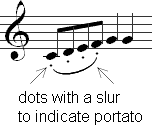Articulation
Articulation indicates how a given note or series of notes is played. Articulation can be categorized in two ways:
- 1. Articulation that affects the written duration of a note. This includes legato, staccato, tenuto, and portato.
- 2. Articulation that controls how a given note is played. This category includes accents and playing techniques, such as sul ponticello.
Articulations that Affect the Duration of a Note
Legato
Legato means smooth and connected. There should be no spaces between the notes. It is indicated by a slur (a curved line) over two or more notes of different pitch. All notes under the slur should be legato.

This shouldn't be confused with ties, which are also curved lines. Ties combine the rhythms of two or more notes of the same pitch.

Staccato
Staccato indicates that a note is to be played in a detached style. This is done by holding the note for less than its full value. There are varying degrees of staccato and symbols for indicating each type.
The first and most common type of staccato is indicated by a dot above or below a note. It is the least detached of all the staccatos. The duration will generally be about half of the note's full value. However, with all staccatos the note value and tempo must be considered when determining how much to shorten a note's value.

Staccatissimo
Staccatissimo means very detached. It is indicated by a wedge symbol place above or below a note.

Tenuto
A tenuto mark over a note indicates to hold that note for its full value.

Portato
Portato is in between a staccato and legato. The note is played slightly shorter than its value so that it isn't quite short enough to be staccato and doesn't connect to the next note to make a legato. It is notated with a slur line and dots over the notes.

Articulation that Affect How a Note is Played
Accents
Accents indicate that a note should be emphasized by playing it louder. There are several kinds of accents, but the three below are the most common:
Regular accent:

Strong accent:

Sforzando: a sudden strong accent

Sul ponticello and sul tasto
Sul ponticello means to play near the bridge. The technique involves picking or plucking the string close to the bridge rather than in the normal playing position. It is indicated with the words 'sul ponticello' over the notes that are to be played this way. If several notes are to be played sul ponticello, a dotted line may be used over the notes in addition to the words.

Sul tasto means to play over the neck of the guitar. It is notated the same way as sul ponticello, but using the words 'sul tasto' instead.

